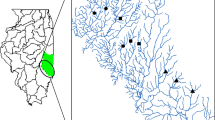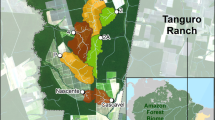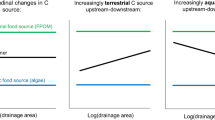Abstract
We examined food web structure in headwater streams to determine whether riparian buffers can mitigate the effects of agricultural land use on stream ecosystem function. Study sites were located in the Midwestern US and divided into three land use groups (forested, buffered, agricultural) based on the amount of riparian forest and row crop agriculture in the watershed. Stable isotope analysis (δ13C and δ15 N) was performed on basal energy sources and consumers (6 invertebrate groups and 7 fish species) with isotopic metrics used to assess variation in food web structure related to land use, instream environmental parameters, and food resources. Land use differences were associated with community-wide isotopic shifts with all trophic diversity metrics greater in forested compared to agricultural streams, whereas buffered streams were generally intermediate. Agricultural streams had compressed food webs with high trophic redundancy indicative of a shared resource pool for all consumers. In contrast, forested and buffered stream food webs showed larger trophic niche area due to greater utilization of detrital energy and higher variability in trophic position among invertebrates and fish. Circular statistics revealed fish communities shifted to lower trophic positions and increased dependence on periphyton production in agricultural streams. The presence of riparian forests was associated with a broader range of resources used by consumers, expanded trophic diversity, and elevated fish trophic position in buffered streams. Results suggest that riparian forests can improve food web structure in streams impacted by croplands and provide further support for restoring buffer areas to moderate adverse effects of agriculture.





Similar content being viewed by others
Availability of data and material
The datasets used and/or analyses during the current study are available from the corresponding author on reasonable request.
References
Adams TS, Sterner RW (2000) The effect of dietary nitrogen content on trophic level N-15 enrichment. Limnol Oceanogr 45:601–607
Allan JD (2004) Landscapes and riverscapes: the influence of land use on stream ecosystems. Annu Rev Ecol Evol Syst 35:257–284
Anderson C, Cabana G (2005) δ15N in riverine food webs: effects of N inputs from agricultural watersheds. Can J Fish Aquat Sci 62:333–340
Anderson C, Cabana G (2007) Estimating the trophic position of aquatic consumers in river food webs using nitrogen isotopes. J N Am Benthol Soc 26:273–285
Barbour M, Stribling J (2006) The multihabitat approach of USEPA’s rapid bioassessment protocols: benthic macroinvertebrates. Limnetica 25:839–849
Batschelet E (1981) Circular statistics in ecology. Academic Press, New York, New York, USA
Baxter CV, Fausch KD, Sauders CW (2005) Tangled webs: reciprocal flows of invertebrate prey link streams and riparian zones. Freshw Biol 50:201–220
Bergfur J, Johnson RK, Sandin L, Goedkoop W (2009) Effects of nutrient enrichment on C and N stable isotope ratios of invertebrates, fish and their food resources in boreal streams. Hydrobiologia 628:67–79
Bernhardt ES, Palmer MA, Allan JD, Alexander G, Barnas K, Brooks S, Carr J, Clayton S, Dahm C, Follstad-Shah J, Galat D, Gloss S, Goodwin P, Hart D, Hassett B, Jenkinson R, Katz S, Kondolk GM, Lake PS, Love R, Meyer JL, O’Don TK (2005) Synthesizing U.S. river restoration. Science 308:636–637
Bigelow DP, Borchers A (2017) Major uses of land in the United States, 2012. U.S. Department of Agriculture, Economic Research Service EIB-178
Brett MT, Bunn SE, Chandra S, Galloway AW, Guo F, Kainz MJ, Kankaala P, Lau DC, Moulton TP, Power ME, Rasmussen JB, Taipale SJ, Thorp JH, Wehr JD (2017) How important are terrestrial organic carbon inputs for secondary production in freshwater ecosystems? Freshw Biol 62:833–853
Bunn SE, Davies PM, Mosisch TD (1999) Ecosystem measures of river health and their response to riparian and catchment degradation. Freshwat Biol 41:333–345
Bunn SE, Leigh C, Jardine TD (2013) Diet-tissue fractionation of d15N by consumers from streams and rivers. Limnol Oceanogr 28:765–773
Cabana G, Rasmussen JB (1996) Comparison of aquatic food chains using nitrogen isotopes. Proc Natl Acad Sci 93:10844–10847
Carvalho DR, Castro D, Callisto M, Moreira MZ, Pampeu PS (2015) Isotopic variation in five species of stream fishes under the influence of different land uses. J Fish Biol 87:559–578
de Carvalho DR, de Castro DMP, Callisto M, Moreira MZ, Pompeu PS (2017) The trophic structure of fish communities from streams in the Brazilian Cerrado under different land uses: and approach using stable isotopes. Hydrobiologia 795:199–217
Dekar MP, Magoulick DD, Huxel GR (2009) Shifts in the trophic base of intermittent streams food webs. Hydrobiologia 635:263–277
Devlin SP, Vander Zanden MJ, Vadeboncoeur Y (2013) Depth-specific variation in carbon isotopes demonstrates resource partitioning among the littoral zoobenthos. Freshwat Biol 58:2389–2400
Diebel MW, Vander Zanden MJ (2009) Nitrogen stable isotopes in streams: effects of agricultural sources and transformations. Ecol Appl 19:1127–1134
Edwards ED, Huryn AD (1996) Effects of riparian land use on contributions of terrestrial invertebrates to streams. Hydrobiologia 337:151–159
Effert-Fanta EL, Fischer RU, Wahl DH (2019) Effects of riparian forest buffers and agricultural land use on macroinvertebrate and fish community structure. Hydrobiologia 841:45–64
Eitzmann JL, Paukert CP (2010) Urbanization in a Great Plains river: Effects of fishes and food webs. River Res and Appl 26:948–959
England LE, Rosemond AD (2004) Small reductions in forest cover weaken terrestrial-aquatic linkages in headwater streams. Freshwat Biol 49:721–734
Erdozain M, Kidd KA, Emilson EJ, Capell SS, Kreutzweiser DP, Gray MA (2021) Elevated allochthony in stream food webs as a result of longitudinal cumulative effects of forest management. Ecosystems. https://doi.org/10.1007/s10021-021-00717-6
ESRI (2005) ArcView GIS 9.1. ESRI, Redlands, California, USA
Evans-White M, Dodds WK, Gray LJ, Fritz KM (2001) A comparison of the trophic ecology of crayfishes and the central stoneroller minnow: omnivory in a tallgrass prairie stream. Hydrobiologia 462:131–144
Feld CK (2013) Response of three lotic assemblages to riparian and catchment-scale land use: implications for designing catchment monitoring programmes. Freshw Biol 58:715–729
Finlay JC (2001) Stable-carbon-isotope ratios of river biota: implications for energy flow in lotic food webs. Ecology 82:1052–1064
Finlay JC, Power ME, Cabana G (1999) Effects of water velocity on algal carbon isotope ratios: implication for river studies. Limnol Oceanogr 44:1198–1203
Fogel ML, Cifuentes LA (1993) Isotope fractionation during primary production. In: Macko SA, Engel MH (eds) Organic geochemistry. Plenum Press, New York, New York, USA, pp 73–96
Garcia L, Cross WR, Pardo I, Richardson JS (2017) Effects of landuse intensification on stream basal resources and invertebrate communities. Freshw Sci 36:609–625
Geddes P, Trexler JS (2003) Uncoupling of omnivore-mediated positive and negative effects on periphyton mats. Oecologia 136:585–595
Gerking SD (1994) Feeding ecology of fish. Academic Press, San Diego, California, USA
Gothe E, Lepori F, Malmqvist B (2009) Forestry affects food webs in norther Swedish coastal streams. Fund Appl Limnol 4:281–294
Guo F, Ebm N, Bunn SE, Brett MT, Hager H, Kainz MJ (2021) Longitudinal variation in nutritional quality of basal food sources and its effect on invertebrates and fish in subalpine rivers. J Anim Ecol 90:2678–2691
Harris D, Horwath WR, Van Kessel C (2001) Acid fumigation of soils to remove carbonates prior to total organic carbon or carbon-13 isotopic analysis. Soil Sci Soc Am 65:1853–1856
Hicks BJ (1997) Food webs in forest and pasture streams in the Waikato region, New Zealand: a study based on analyses of stable isotopes of carbon and nitrogen, and fish gut contents. NZ J Mar Freshw Res 31:651–664
Hladyz S, Abjornsson K, Giller PS, Woodward G (2011a) Impacts of an aggressive riparian invader on community structure and ecosystem functioning in stream food webs. J Appl Ecol 48:443–452
Hladyz S, Abjornsson K, Chauvet E, Dobson M, Elosegi A, Ferreira V, Fleituch T, Gessner MO, Giller PS, Gulis V, Hutton SA, Lacoursiere JO, Lamothe S, Lecerf A, Malmqvist B, McKie BG, Nistorescu M, Preda E, Riipinen MP, Risnoveanu G, Schindler M, Tiegs SD, Vought LB, Woodward G (2011b) Stream ecosystem functioning in an agricultural landscape: the importance of terrestrial-aquatic linkages. J Appl Ecol 48:443–452
Hogsden KL, Harding JS (2014) Isotopic metrics as a tool for assessing the effects of mine pollution on stream food webs. Ecol Indic 32:339–347
Hrodey PJ, Sutton TM, Frimpong EA (2009) Land-use impacts on watershed health and integrity in Indiana warmwater streams. Am mid Nat 161:76–95
Inoue M, Sakamoto S, Kikuchi S (2013) Terrestrial prey inputs to streams bordered by deciduous broadleaved forests, conifer plantations and clear-cut sites in southwestern Japan: effects on the abundance of red-spotted masu salmon. Ecol Freshwat Fish 22:335–347
Jackson AL, Inger R, Parnell AC, Bearhop S (2011) Comparing isotopic niche widths among and within communities: SIBER – Stable Isotope Bayesian Ellipses in R. J Anim Ecol 80:595–602
Jardine T, Gray MA, McWilliam SM, Cunjak RA (2005) Stable isotope variability in tissue of temperate stream fishes. Trans Am Fish Soc 134:1103–1110
Kawaguchi Y, Taniguchi Y, Nakano S (2003) Terrestrial invertebrate inputs determine the local abundance of stream fishes in a forested stream. Ecology 84:701–708
Kendall C (1998) Tracing nitrogen sources and cycling in catchments. In: Kendall C, McDonnell JJ (eds) Isotope tracers in catchment hydrology. Elsevier, Amsterdam, The Netherlands, pp 519–576
Kovach WL (2009) Oriana-Circular statistics for Windows, version 3. Kovach Computing Services, Pentraeth, Wales, UK
Lake PS, Bond N, Reich P (2007) Linking ecological theory with stream restoration. Freshw Biol 52:597–615
Lau DC, Leung KM, Dudgeon D (2009) What does stable isotope analysis reveal about trophic relationships and the relative importance of allochthonous and autochthonous resources in tropical streams? A synthetic study from Hong Kong. Freshw Biol 54:127–141
Layman CA, Post DM (2008) Can stable isotope ratios provide for community-wide measures of trophic structure? Reply. Ecology 89:2358–2359
Layman CA, Arrington DA, Montana CG, Post DM (2007a) Can stable isotope ratios provide for community-wide measures of trophic structure? Ecology 88:42–48
Layman CA, Quattrochi JP, Peyer CM, Allgeier JE (2007b) Niche width collapse in a resilient top predator following ecosystem fragmentation. Ecol Lett 10:937–944
Layman CA, Araujo MS, Hammerschlag-Peyer CM, Harrison E, Jud ZR, Matich P, Rosenblatt AE, Vaudo LL, Yeager LA, Post DM, Bearhop S (2012) Applying stable isotopes to examine food-web structure: and overview of analytical tools. Biol Rev 87:545–562
Lee KY, Graham L, Spooner DE, Xenopoulos MA (2018) Tracing anthropogenic inputs in stream foods webs with stable carbon and nitrogen isotope systematics along an agricultural gradient. PLoS ONE 13(7):e0200312
Lovell SR, Sullivan WC (2006) Environmental benefits of conservation buffers in the United States: Evidence, promise, and open questions. Agric Ecosyst Environ 112:249–260
Machado-Silva F, Neres-Lima V, Oliveira AF, Moulton TP (2022) Forest cover control the nitrogen and carbon stable isotopes of rivers. Sci Total Environ 817:152784
Malmqvist B, Rundle S (2002) Threats to the running water ecosystems of the world. Environ Conserv 29:134–153
March JG, Pringle CM (2003) Food web structure and basal resource utilization along a tropical island stream continuum, Puerto Rico. Biotropica 35:84–93
Marshall DW, Fayram AH, Panuska JC, Baumann J, Hennessy J (2008) Positive effects of agricultural land use changes on coldwater fish communities in Southwest Wisconsin stream. N Am J Fish Manag 28:944–953
Merritt RW, Cummins KW (1996) An introduction to the aquatic insects of North American, 3rd edn. Kendall/Hunt Publishing Company, Dubuque, Iowa, USA
Milanovich JR, Berland A, Hopton ME (2014) Influence of catchment land cover on stoichiometry and stable isotope compositions of basal resources and macroinvertebrate consumers in headwater streams. J Freshw Ecol 29:565–578
Minagawa M, Wada E (1984) Stepwise enrichment of 15N along food chains: further evidence and the relation between d15N and animal age. Geochem Cosmochim Acta 48:1135–1140
Naiman RJ, Decamps H (1997) The ecology of interfaces: riparian zones. Annu Rev Ecol Syst 28:621–658
Nakano S, Murakami M (2001) Reciprocal subsidies: Dynamic interdependence between terrestrial and aquatic food webs. P Natl Acad Sci 98:166–170
Nakano S, Miyasaka H, Kuhara N (1999) Terrestrial aquatic linkages: riparian arthropod inputs alter trophic cascades in a stream food web. Ecology 80:2435–2441
National Research Council (NRC) (2002) Riparian Areas: functions and strategies for management. National Academy Press, Washington, D.C., USA
Olsen AR, Peck DV (2008) Survey design and extent estimates for the Wadeable Streams Assessment. Freshw Sci 27:822–836
Peterson BJ, Fry B (1987) Stable isotopes in ecosystem studies. Ann Rev Ecol and Syst 18:293–320
Post DM (2002) Using stable isotopes to estimate trophic position: models, methods, and assumptions. Ecology 83:703–718
Post DM, Takimoto G (2007) Proximate structural mechanisms for variation in food-chain length. Oikos 116:775–782
Post DM, Conners DM, Goldberg DS (2000) Prey preference by a top predator and the stability of linked food chains. Ecology 81:8–14
Post DM, Layman CA, Arrington DA, Takimoto G, Quattrochi J, Montana CF (2007) Getting to the fat of the matter: models, methods, and assumptions for dealing with lipid in stable isotope analyses. Oecologia 152:179–189
Power ME (1990) Effects of fish in river food webs. Science 250:811–814
R Development Core Team. 2012. R: a language and environment for statistical computing. R Foundation for Statistical Computing, Vienna, Austria
Rooney N, McCann K, Gellner G, Moore JC (2006) Structural asymmetry and the stability of diverse food webs. Nature 442:265–269
Sargeant BL, Gaiser EE, Trexler JC (2010) Biotic and abiotic determinants of intermediate-consumer trophic diversity in the Florida everglades. Mar Freshw Res 61:11–22
SAS Institute Inc. (2012) SAS version 9.3 SAS Institute, Cary, North Carolina, USA
Schmidt SN, Olden JD, Solomon CT, Vander Zanden MJ (2007) Quantitative approaches to analysis of stable isotope food web data. Ecology 88:2793–2802
Smiley PC, Gillespie RB, King KW, Huang C (2009) Management implications of the relationship between water chemistry and fishes within channelized headwater streams in the Midwestern United States. Ecohydrolog 2:294–302
Sullivan ML, Zhang Y, Bonner TH (2012) Terrestrial subsidies in the diets of stream fishes of the USA: comparison among taxa and morphology. Mar Freshw Res 63:409–414
Sweeney BW (1993) Effects of streamside vegetation on macroinvertebrate communities of White Clay Creek in Eastern North America. Proc Acad Nat Sci Phila 144:291–340
Thorp JH, Delong MD (2002) Dominance of autochthonous autotrophic carbon in food webs of heterotrophic rivers. Oikos 96:543–550
Vander Zanden MJ, Rasmussen JB (2001) Variation in d15N and d13C trophic fractionation: implications for aquatic food web studies. Limnol Oceanogr 46:2061–2066
Vannote RL, Minshall GW, Cummins KW, Sedell JR, Cushing CE (1980) The river continuum concept. Can J Fish Aquat Sci 37:130–137
Wallace JB, Whiles MR, Eggert S, Cuffney TF, Lugthart GH, Chung K (1995) Long-term dynamics of coarse particulate organic matter in three Appalachian mountain streams. J N Am Benthol Soc 14:217–232
Wiley MJ, Osborne LL, Larimore RW (1990) Longitudinal structure of an agricultural prairie river systems and its relationship to current stream ecosystem theory. Can J Fish Aquat Sci 47:373–384
Woodland RJ, Magnan P, Glemet H, Rodriguez MA, Cabana G (2012) Variability and directionality of temporal changes in δ13C and δ15N of aquatic invertebrate primary consumers. Oecologia 169:199–209
Woodward G (2009) Biodiversity, ecosystem functioning and food webs in freshwaters: assembling the jigsaw puzzle. Freshw Biol 54:2171–2187
Woodward G, Papantoniou G, Edwards F, Lauridsen RB (2008) Trophic trickles and cascades in a complex food web: impacts of a keystone predator on stream community structure and ecosystem processes. Oikos 117:683–692
Acknowledgements
We thank Shaun Chow, Hannah Grant, and undergraduates at the University of Illinois for help in the field and laboratory. We also thank the University of Illinois graduate students and staff at the Illinois Natural History Survey’s Kaskaskia Biological Station for their valuable feedback. We would like to acknowledge the helpful comments of Scott Collins and two anonymous reviewers that improved the manuscript. This work was supported by research grants from the Illinois American Fisheries Society and Illinois-Indiana Sea Grant College Program, and a dissertation completion fellowship from the University of Illinois to Eden Effert-Fanta.
Author information
Authors and Affiliations
Contributions
Eden Effert-Fanta conceived of the study idea. All authors contributed to the study design. Field work, lab processing and data analyses were completed by Eden Effert-Fanta. Eden Effert-Fanta wrote the first draft of the manuscript. Robert Fischer and David Wahl provided editorial advice.
Corresponding author
Ethics declarations
Conflicts of interest
The authors declare that they have no conflict of interest.
Ethical approval
All applicable institutional and/or national guidelines for the care and use of animals were followed.
Additional information
Publisher's Note
Springer Nature remains neutral with regard to jurisdictional claims in published maps and institutional affiliations.
Rights and permissions
Springer Nature or its licensor holds exclusive rights to this article under a publishing agreement with the author(s) or other rightsholder(s); author self-archiving of the accepted manuscript version of this article is solely governed by the terms of such publishing agreement and applicable law.
About this article
Cite this article
Effert-Fanta, E.L., Fischer, R.U. & Wahl, D.H. Riparian and watershed land use alters food web structure and shifts basal energy in agricultural streams. Aquat Sci 84, 61 (2022). https://doi.org/10.1007/s00027-022-00895-y
Received:
Accepted:
Published:
DOI: https://doi.org/10.1007/s00027-022-00895-y




